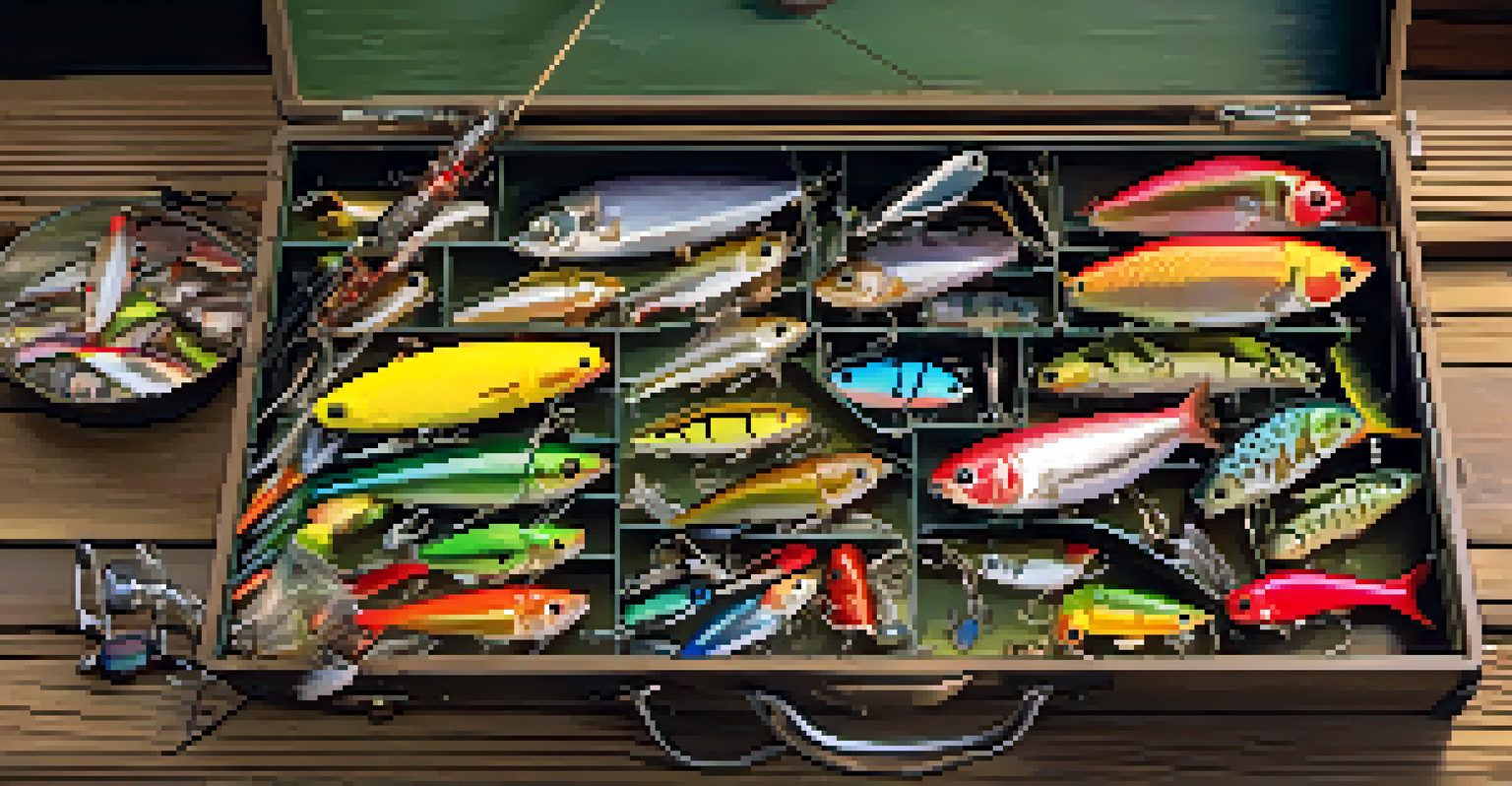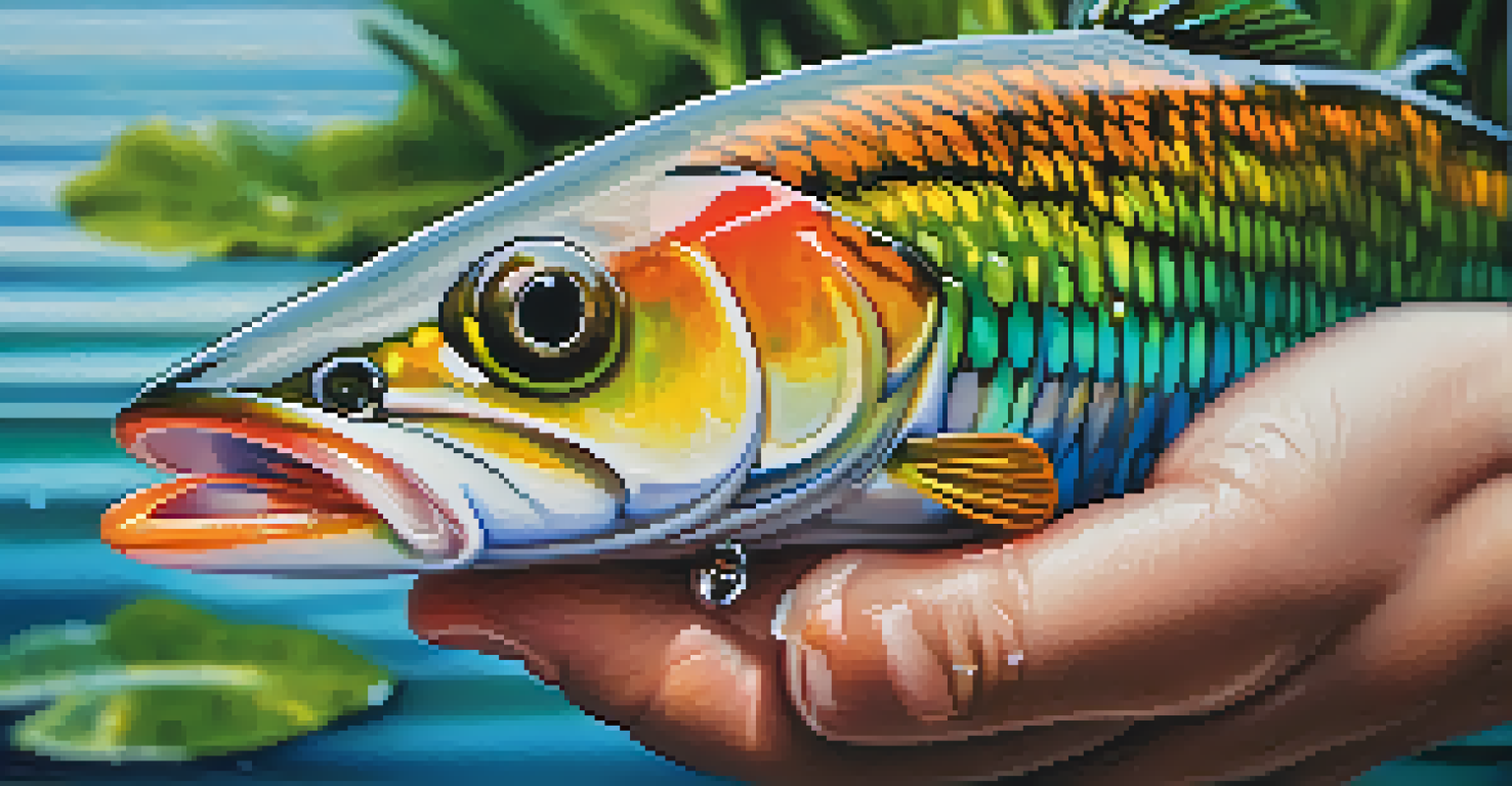How to Choose the Right Bait for Successful Fishing

Understanding Different Types of Fishing Bait
Fishing bait comes in various forms, and understanding these can significantly improve your chances of catching fish. Live bait, such as worms and minnows, mimics the natural food fish seek in their habitat. On the other hand, artificial baits, which include lures and jigs, can be designed to imitate the movement and color of prey.
Give a man a fish and you feed him for a day. Teach a man to fish and you feed him for a lifetime.
Each type of bait has its advantages; for example, live bait often attracts fish more effectively due to its natural scent and movement. However, artificial baits can be more versatile and easier to handle, making them a popular choice for many anglers. Knowing the different types of bait available is the first step in making the right choice.
Ultimately, the bait you choose should depend on the type of fish you are targeting, the fishing environment, and your personal preference as an angler. By familiarizing yourself with the options, you'll be better equipped to make an informed decision.
Match the Bait to Your Target Fish Species
Different fish species have unique feeding habits and preferences, which means that the bait you choose should correspond with the species you aim to catch. For instance, bass are often attracted to worms or crankbaits, while trout might respond better to small spoons or flies. Knowing your target species is crucial for successful fishing.

Researching the types of bait that are most effective for specific fish can give you an edge. Local fishing guides, bait shops, and online forums can provide valuable insights into what works best in your area. For example, if you're fishing in a lake known for its crappie population, small minnows or jigs could be your best bets.
Choose Bait for Target Species
Selecting the right bait based on the specific fish species you are targeting is crucial for successful fishing.
Moreover, keeping track of seasonal changes in fish behavior can also help you adjust your bait selection. Some fish might be more active during certain times of the year, making it essential to adapt your bait strategy accordingly.
Consider the Fishing Environment and Conditions
The fishing environment plays a significant role in bait selection. Freshwater and saltwater fish may have different preferences, and even the specific body of water can influence what bait is most effective. For example, in murky waters, using brightly colored lures can help attract fish, while clear waters might require more natural-looking options.
Fishing is not an escape from life, but often a deeper immersion into it.
Weather conditions also impact fish behavior, affecting how and when they feed. For example, fish may feed more actively during cloudy days, so using livelier bait can capitalize on that increased activity. Conversely, on a sunny day, fish might seek shade, making it crucial to choose bait that can entice them into more open areas.
Understanding these environmental factors can help you refine your bait choices, leading to a more successful fishing experience. By paying attention to the surroundings, you can adapt your strategy and improve your chances of catching your desired fish.
Experimenting with Different Bait Options
Fishing is often about trial and error. Don't hesitate to experiment with various bait types to see what works best for you and the specific conditions. It's not uncommon for anglers to switch bait multiple times during a single outing until they find the right combination that attracts fish.
Keep in mind that what works one day might not work the next, so being flexible and willing to try new things is key. For instance, if you're fishing in a spot where you usually catch fish using worms, but they aren't biting, consider switching to a lure or different color to spark their interest.
Adapt to Environmental Conditions
Understanding the fishing environment and conditions can help refine your bait selection for better results.
Documenting your fishing experiences can also help you identify patterns over time. By noting down what bait worked best under specific conditions, you'll build a personal reference guide that can inform your future fishing trips.
Using Scent and Color to Attract Fish
When it comes to fishing bait, scent and color can significantly influence your success rate. Many fish rely on their sense of smell to locate food, so using bait with a strong natural scent can give you an advantage. Scented baits, such as those infused with fish oils or other attractants, can entice fish that might otherwise ignore your offering.
Color also plays a crucial role in attracting fish. Brightly colored lures can stand out in murky water and grab the attention of nearby fish. In contrast, more natural hues may be more effective in clear water conditions. By adjusting the color of your bait based on the fishing environment, you can enhance your chances of drawing in your target species.
Experimenting with both scent and color can help you determine what works best for your fishing situation. By observing the behaviors of fish in response to different bait options, you can tailor your approach for greater success.
The Importance of Presentation and Technique
Choosing the right bait is only part of the equation; how you present that bait is equally important. The technique you use can affect how fish perceive your offering. For example, when using live bait, ensuring it's lively and moving naturally can entice fish to strike.
If you're using lures, varying your retrieve speed and style can create a more realistic presentation. Jerking the rod, pausing, or reeling in slowly can mimic the erratic movements of injured prey, which might trigger a predatory response from fish. Adapting your presentation based on the fish's behavior and mood can lead to more bites.
Leverage Local Fishing Knowledge
Engaging with local anglers and resources can provide valuable insights into the most effective bait for your area.
Practice makes perfect when it comes to mastering your bait presentation. Observing and learning from experienced anglers can provide valuable insights that enhance your technique, ultimately increasing your success on the water.
Local Knowledge: The Key to Successful Bait Selection
One of the most valuable resources for choosing the right bait is local knowledge. Engaging with local anglers, visiting bait shops, or joining fishing communities can provide you with insights tailored to your fishing spot. Often, seasoned fishermen are more than willing to share their experiences and recommendations for bait that works well in specific locations.
Additionally, many regions have specific bait regulations that you should be aware of. Some areas may restrict the use of live bait, while others may have seasonal rules regarding certain species. Being informed about these regulations not only keeps you compliant but also helps you select the most effective bait.

By tapping into the local fishing culture, you can gain a wealth of knowledge that enhances your fishing experience. Building relationships with other anglers can lead to valuable tips and tricks that can significantly improve your success on the water.